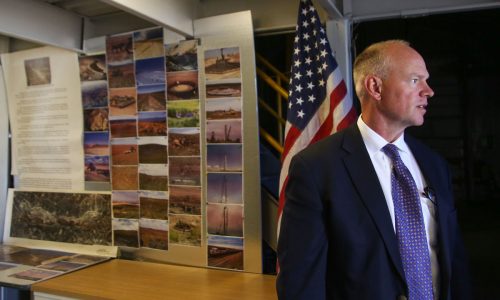Wyoming Gov. Matt Mead says he’s hopeful that state lawmakers won’t have to make more substantial cuts to state spending when they convene early next year.
Declining revenues forced Mead to cut $250 million from the state’s two-year, $3 billion general fund budget that started in July. Updated revenue projections are due later this month and Mead said he doesn’t expect to see them change much from this summer’s projections.
“It may go up or down some, but I don’t think we’re going to see a huge drop off,” Mead said Tuesday. “I certainly don’t think we’re going to see a huge increase. Which would mean that the cuts that I had to make I think hopefully will prove to be just about right as we head into the session, at which time we’ll see if additional cuts are needed or not.”
If the Legislature determines that more budget cuts are required, Mead said the results will be painful throughout state government.
“We’re on the edge now,” Mead said. “I don’t know of hardly any place you could cut without causing layoffs, and we’re already going to see reduction in services and every cut beyond that is additional reduction in services. So these are difficult cuts that have been made. Each future cut would be all the more difficult.”
State fiscal analysts responsible for drafting the revenue forecast set for release this month said Wednesday they’re not ready to discuss their report.
Wyoming relies heavily on energy production for revenue. Coal production in the state is down sharply so far this year compared with last year. Several large coal companies have sought bankruptcy protection recently and Wyoming has seen sizable layoffs among miners working in the Powder River Basin.
Travis Deti, executive director of the Wyoming Mining Association, said he expects coal production will increase slightly in the second half of this year.
Deti said coal production is being helped by factors such as rising natural gas prices, a decline in coal stockpiles at utilities and other factors. “We’re down, but we’re not out, and I think we’re going to see a little bit of an increase in production here in the second half of the year,” he said Wednesday.
Sen. Tony Ross, R-Cheyenne, is chairman of the Senate Appropriations Committee. He said Wednesday he believes the Legislature may have to impose more budget cuts.
Ross, who’s leaving the Legislature at the end of this year, said the state still faces an anticipated general fund shortfall of about $250 million for the current two-year funding period.
The state also faces a shortfall in its School Foundation Program, which covers construction and maintenance. The state in recent years has used federal coal lease bonus money to pay for billions of dollars in school construction.
Wyoming still has roughly $1.5 billion in its so-called rainy day fund, but Ross said many lawmakers don’t want to spend more from the fund after dipping into it for about $300 million already in the budget session earlier this year.

